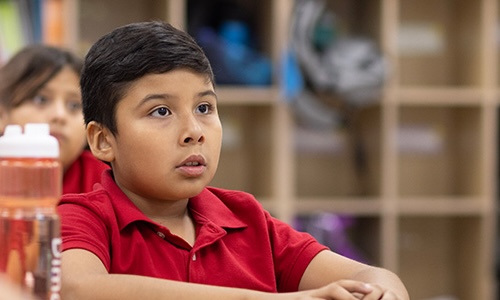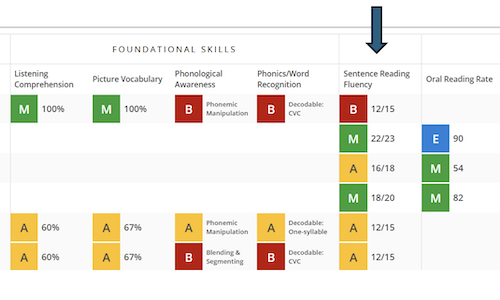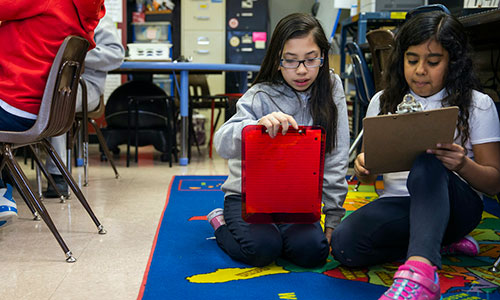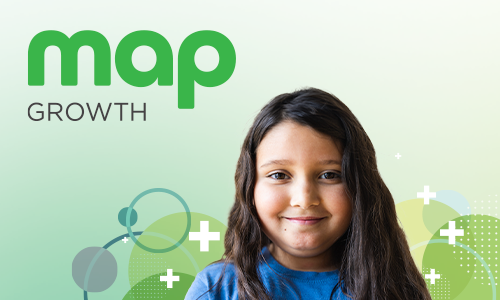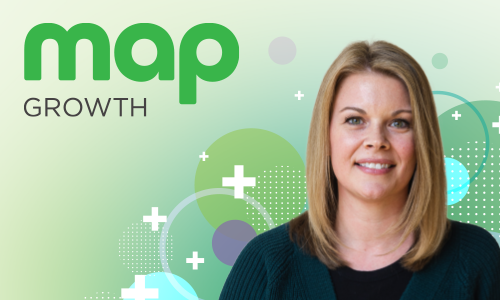
Remember Philip Gough and William Tunmer’s Simple View of Reading? That’s the concise equation stating that reading comprehension is the product of word recognition (turning letters on a page into their corresponding sounds) and language comprehension (listening to language for the purpose of extracting and constructing meaning). Here’s that equation in graphic form:

In my last article, I explored the word recognition part of this equation. I explained how MAP® Reading Fluency™ with Coach, the AI-powered tutoring solution from NWEA, delivers evidence-based, just-in-time microinterventions to help readers develop and refine this key skill. Today I’d like to turn my attention to the other essential part of the equation: language comprehension.
All about language comprehension
Language comprehension, very simply, is what happens when readers go beyond turning letters into sounds and begin to understand the full meaning that words convey. It’s a simple concept, but in practice, it’s a multifaceted process with a lot happening under the surface.
You may recall that language comprehension is a key component of not only the Simple View of Reading, but also Hollis Scarborough’s Strand Model of Skilled Reading (a.k.a., the Reading Rope), which weaves together strands that are necessary for reading acquisition into the durable tapestry we call skilled reading. Word recognition makes up one of the domains of the Reading Rope, and the other domain is —you guessed it—language comprehension. I mention these frameworks again because MAP Reading Fluency with Coach wouldn’t exist without them. They’re the scientific foundation upon which this state-of-the-art tutoring program was built.
The language comprehension part of the Reading Rope is composed of the following strands:
- Background knowledge is the prior knowledge one possesses, which must be utilized to comprehend what we hear or read. It’s one thing to master decoding (turning letters into their corresponding sounds) and quite another to have the foundation of content knowledge that makes extracting and constructing meaning possible.
- Vocabulary encompasses understanding both the meaning and pronunciation of words. It’s important to have a large storehouse of known words, as it supports decoding, and when we know what words mean, it supports our ability to understand.
- Language structures refer to how language is organized to impart meaning. At the word level, it includes awareness of morphological structures, like base words, prefixes, and suffixes. Morphological awareness acts as a bridge that connects word recognition to language comprehension. At the sentence level, language structures include knowing how word choice creates meaning (or semantic knowledge) and knowing the rules of grammar for a language (or syntactic knowledge).
- Verbal reasoning refers to one’s ability to analyze and deduce meaning from both explicit and implicit information. It extends beyond basic recall of what was heard or read and involves making logical inferences, integrating ideas, and interpreting figurative language. Think of verbal reasoning as problem-solving words to extract and construct meaning.
- Literacy knowledge encompasses all the concepts one knows about language, books, and their contents. It includes, for example, knowing the difference between fiction and poetry, as well as knowledge of print concepts and text features. These details make up the background knowledge that sets the stage for improved comprehension.
One way to distinguish word recognition from language comprehension is that the former becomes increasingly automatic. Language comprehension, on the other hand, becomes increasingly strategic as readers progress toward skilled reading.
Putting theory into practice with targeted interventions
Let’s look at the language comprehension microinterventions that are built into MAP Reading Fluency with Coach. These interventions are loaded and ready to go for real-time implementation as students interact with Maya, the AI-powered avatar who functions as their personal coach. As students read aloud, Maya actively listens just as a human teacher or tutor would—and when she detects an oral reading error, she delivers customized support to help students move past the obstacles in their way.
Here are some examples of language comprehension microinterventions that Maya delivers when she detects an error, along with the specific Reading Rope domains they are designed to address:
- Homonyms. Maya selects a word that is a homonym and then asks the student to select the best definition of the word. (vocabulary, background knowledge)
- Vocabulary quiz. Maya provides the definition for the selected word and then asks the student to select the image that best represents the word. (vocabulary, background knowledge)
- Fun fact. Maya shows the selected word along with an amusing picture, and she relays a fun fact where the word is mentioned one or more times. (background knowledge, vocabulary)
- Mid-story comprehension question. Maya deploys a multiple-choice comprehension question to check for understanding during a story. (comprehension, vocabulary)
- Morpheme roots intervention. Maya highlights a root, then explains what it means. The student is asked to name another word that uses the root. Maya then provides a word. (language structure, vocabulary, background knowledge)
- Suffix intervention. Maya highlights a suffix and then explains what it means. The student is asked to name another word that uses the suffix. (language structure, vocabulary)
Watching readers grow
It won’t take long for your readers to encounter and start benefiting from the microinterventions described above. In fact, NWEA recommends that students start with a half hour of practice per week with MAP Reading Fluency with Coach. Because the program is so responsive and personalized, you’ll start seeing results right away.
And, of course, you do need to see those results to know how your students are doing and what they need next. Insight into your students’ progress and growth is one of the most valuable takeaways from MAP Reading Fluency with Coach. This is where the reports come in. I’ll share ideas for how to get the most value out of these reports in a future article.
